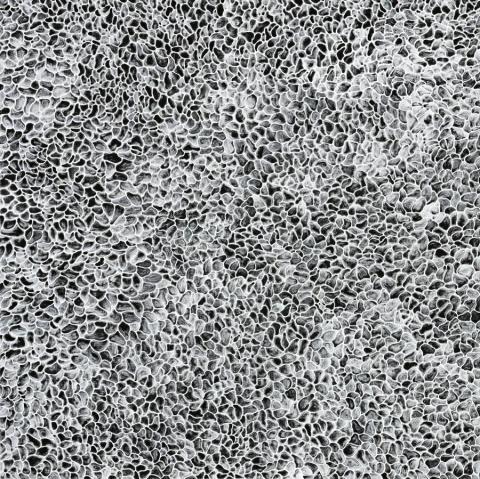HEART [AOWHTON], 2007
YAYOI KUSAMA
synthetic polymer paint on canvas
146.0 x 146.0 cm
signed, dated and inscribed verso: HEART [AOWHTON] / Yayoi Kusama / 2007
Ota Fine Arts, Tokyo (label attached verso)
Roslyn Oxley9 Gallery, Sydney (label attached verso)
Private collection, Sydney
Yayoi Kusama, Roslyn Oxley9 Gallery, Sydney, 26 April - 19 May 2007, cat. 6
Yayoi Kusama: Mirrored Years, Museum of Contemporary Art, Sydney, 24 February - 8 June, 2009
'By obliterating one's individual self, one returns to the infinite universe.'1
One of the most exciting, original and prolific artists of our time, Yayoi Kusama has remained at the forefront of developments in contemporary art practice for over half a century. Widely respected for an endlessly vibrant and stylistically varied oeuvre encompassing painting, sculpture, poetry, fiction, performance, film-making, fashion, installation and public spectacle (or 'happenings'), her influence may be discerned in tendencies as diverse as Pop Art, Surrealism, Minimalism, the Zero and Nul movements, Eccentric Abstraction and Feminist art. Notably however, Kusama herself consistently eludes any singular classification, occupying a highly unique role as the eternal 'insider-outsider'. Whether as an Asian woman in the male-dominated New York art scene of the 1960s, or as a liberated, worldly artist in conservative Japan, indeed she transcends gender, generation, geography and even the very notion of art itself in her infinite consciousness and enduring mission to reveal through her mysterious and highly idiosyncratic forms the 'invisible interconnectedness' of everything within the cosmos.
Born in 1929 in the hinterland town of Matsumoto, Japan, Kusama suffered a traumatic family life and oppressive early artistic training in the traditional manner of Japanese Nihonga painting a rigorous formal style which she perceived as tainted by association with Nationalist rule - before finally making the radical decision to move to the New York in 1958. Propelled by a seemingly insatiable desire to not only develop a Western-style of painting but position herself within the international avant-garde, Kusama later recalled, 'For art like mine' art that does battle at the boundary between life and death, questioning what we are and what it mean to live and die - [Japan] was too small, too servile, too feudalistic, and too scornful of women. My art needed a more unlimited freedom and a wider world.'2 Ever the frenetic experimenter, Kusama quickly absorbed everything this dynamic city had to offer, cultivating friendships with influential figures such as Donald Judd, Frank Stella and Joseph Cornell, and unashamedly exploiting her exotic 'Oriental' allure to gain attention in a manner reminiscent of fellow consummate self-publicist, Andy Warhol.
After just a year, she had revolutionised the local art scene with her first series of astonishing 'Infinity Net paintings' unveiled in 1959 'vast canvases measuring up to 33 feet in width and entirely covered in rhythmic undulations tirelessly repeated '... without beginning, end or centre'.3 Stemming from hallucinations that had plagued the artist since childhood whereby objects surrounding her became unified in a single pattern, these seminal works encapsulated what would become Kusama's signature motifs, the net and its negative space the polka dot - 'two interchangeable idioms that she adopted as her alter ego, her logo, her franchise and weapon of incursion into the world at large'.4 Moreover, the series heralded the beginning of a resolutely disciplined and single-minded performance spanning more than six decades that, like her art, would continually repeat and obliterate itself. With its mesmerising, transcendent beauty, monochromatic palette and contemplation of the infinite through obsessive lattice patterning, the present Heart [AOWHTON], 2007 finds its origins in those early groundbreaking paintings, now widely extolled as her crowning achievement - as attested by the sale of one composition at Christie's in 2008 for an astounding $5.2 million, representing the highest price ever paid for work by a female living artist.
Despite once reputedly being 'as famous as Warhol'5, during the decades following her return to Japan permanently in 1973 Kusama remained in relative obscurity, living and working from a studio built adjacent to the mental institution where she admitted herself. Encouraged by the overwhelming success of her Infinity Mirror Room installation for the Japanese Pavilion at the 45th Venice Biennale in 1993, Kusama has since embarked upon several major outdoor sculptural commissions, and today is enjoying a long-overdue, widespread revival of interest with several major survey exhibitions, including Love Forever (1998) at the Museum of Modern Art, New York and touring to Los Angeles County Museum of Art and Museum of Contemporary Art, Tokyo; KUSAMATRIX (2004) Mori Art Museum, Tokyo; Yayoi Kusama: Mirrored Years (2009) at the Museum of Contemporary Art, Sydney (in which the present work on offer was included); and most recently, Yayoi Kusama (2012) organised by Tate Modern, London and touring to various venues across Europe.
1. Kusama, Y., Infinity Net: The Autobiography of Yayoi Kusama, London, 2011
2. Kusama, ibid., p. 93
3. Kusama cited in Hoptman, L., 'Yayoi Kusama: A reckoning', in Yayoi Kusama, Phaidon Press, London, 2000, p. 103
4. Hoptman, ibid., p. 344
5. Solomon, A., 'Dot, Dot, Dot', Artforum, February 1997, p. 100
VERONICA ANGELATOS
